英文文献002:差异化营销策略
外文文献(市场营销策略)
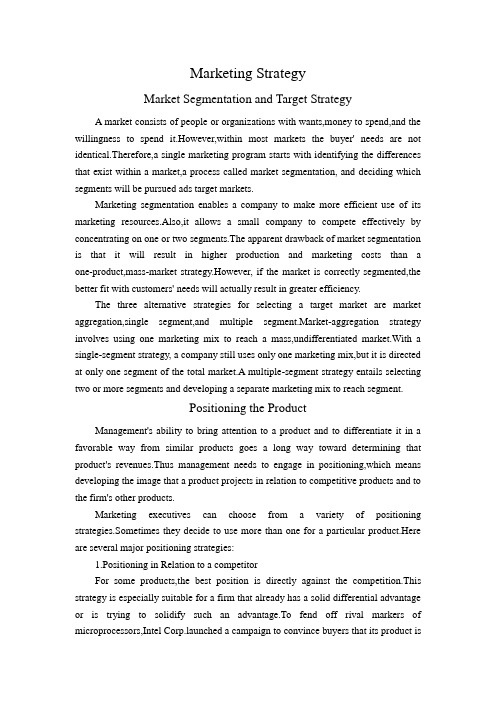
Marketing StrategyMarket Segmentation and Target StrategyA market consists of people or organizations with wants,money to spend,and the willingness to spend it.However,within most markets the buyer' needs are not identical.Therefore,a single marketing program starts with identifying the differences that exist within a market,a process called market segmentation, and deciding which segments will be pursued ads target markets.Marketing segmentation enables a company to make more efficient use of its marketing resources.Also,it allows a small company to compete effectively by concentrating on one or two segments.The apparent drawback of market segmentation is that it will result in higher production and marketing costs than a one-product,mass-market strategy.However, if the market is correctly segmented,the better fit with customers' needs will actually result in greater efficiency.The three alternative strategies for selecting a target market are market aggregation,single segment,and multiple segment.Market-aggregation strategy involves using one marketing mix to reach a mass,undifferentiated market.With a single-segment strategy, a company still uses only one marketing mix,but it is directed at only one segment of the total market.A multiple-segment strategy entails selecting two or more segments and developing a separate marketing mix to reach segment.Positioning the ProductManagement's ability to bring attention to a product and to differentiate it in a favorable way from similar products goes a long way toward determining that product's revenues.Thus management needs to engage in positioning,which means developing the image that a product projects in relation to competitive products and to the firm's other products.Marketing executives can choose from a variety of positioning strategies.Sometimes they decide to use more than one for a particular product.Here are several major positioning strategies:1.Positioning in Relation to a competitorFor some products,the best position is directly against the competition.This strategy is especially suitable for a firm that already has a solid differential advantage or is trying to solidify such an advantage.To fend off rival markers of microprocessors,Intel unched a campaign to convince buyers that its product issuperior to competitors.The company even paid computer makers to include the slogan,"Intel Inside" in their ads.As the market leader,Coca-Cola introduces new products and executes its marketing strategies.At the same time,it keeps an eye on Pepsi-Cola,being sure to match any clever,effective marketing moves made by its primary competitor.2.Positioning in Relation to a Product Class or AttributeSometimes a company's positioning strategy entails associating its product with(or distancing it from)a product class or attributes.Some companies try to place their products in a desirable class,such as"Made in the USA."In the words of one consultant,"There is a strong emotional appeal when you say,'Made in the USA'".Thus a small sportswear manufacturer,Boston Preparatory Co.is using this positioning strategy to seek an edge over large competitors such as Calvin Klein and Tommy Hilfiger,which don't produce all of their products in the U.S..3.Positioning by Price and QualityCertain producer and retailers are known for their high-quality products and high prices.In the retailing field,Sake Fifth Avenue and Neiman Marcus are positioned at one end of the price-quality continuum.Discount stores such as Target and Kmart are at the other.We're not saying,however,that discounters ignore quality;rather, they stress low prices.Penney's tired—and for the most part succeeded in—repositioning its stores on the price-quality continuum by upgrading apparel lines and stressing designer names.The word brands is comprehensive;it encompasses other narrower terms.A brand is a name and/or mark intended to identify the product of one seller or group of sellers and differentiate the product from competing products.A brand name consists of words,letters,and/or numbers that can be vocalized.A brand mark is the part of the brand that appears in the form of a symbol, design,or distinctive color or lettering.A brand mark is recognized buy sight bu cannot be expressed when a person pronounces the brand name.Crest,Coors,and rider for Ralph Lauren's Polo Brand.Green Giant(canned and frozen vegetable products)and Arm&Hammer(baking soda)are both brand names and brand marks.A trademark is a brand that has been adopted by a seller and given legal protection.A trademark includes not just the brand mark,as many people believe,but also the brand name.The Lanham Act of 1946 permits firms to register trademarks with the federal government to protect them from use or misuse by othercompanies.The Trademark Law Revision Act,which took effect in 1989,is tended to strengthen the the registration system to the benefit of U.S. Firms.For sellers,brands can be promoted.They are easily recognized when displayed in a store or included in advertising.Branding reduces price comparisons.Because brands are another factor that needs to be considered in comparing different products,branding reduces the likelihood of purchase decision based solely on price.The reputation of a brand also influences customer loyalty among buyers of services as well as customer goods.Finally,branding can differentiate commodities(Sunkist oranges,Morton salt,and Domino sugar,for example).PricingPricing is a dynamic process,Companies design a pricing structure that covers all their products.They change this structure over time and adjust it to account for different customers and situations.Pricing strategies usually change as a product passes through its life cycle.Marketers face important choice when they select new product pricing strategies.The company can decide on one of several price-quality strategies for introducing an imitative product.In pricing innovative products,it can practice market-skimming pricing by initially setting high prices to"skim"the maximum amount of revenue from various segments of the market.Or it can use market penetration pricing by setting a low initial price to win a large market share.Companies apply a variety of price-adjustment strategies to account for differences in consumer segments and situations.One is discount and allowance pricing,whereby the company decides on quantity,functional,or seasonal discounts,or varying types of allowances. A second strategy is segmented pricing, where the company sellers a product at two or more prices to allow for differences in customers, products, or locations. Sometimes companies consider more than economics in their pricing decisions,and use psychological pricing to communicate about the product's quality or value.In promotional pricing,companies temporarily sell their product bellow list price as a special-event to draw more customers,sometimes even selling below cost.With value pricing, the company offers just the night combination of quality and good service at a fair price. Another approach is geographical pricing, whereby the company decides how to price distant customers, choosing from alternative as FOB pricing,uniform delivered pricing, zone pricing, basing-point pricing, and freight-absorption pricing. Finally, international pricing means that thecompany adjusts its price to meet different world markets.Distribution ChannelsMost producers use intermediaries to bring their products to market.They try to forge a distribution channel—a set of interdependent organizations involved in the process of marking a product or service available for use or consumption by the consumers or business user.Why do producers give some of the selling job to intermediaries?After all,doing so means giving up some control over how and to whom the products are sold.The use of intermediaries results from their greater efficiency in marking goods available to target markets.Through their contacts, experience, specialization, and scales of operation,intermediaries usually offer the firm move value than it can achieve on its own efforts.A distribution channel moves goods from producers to customers.It overcomes the major time, place, and possession gaps that separate goods and services from those who would use them. Members of the marketing channel perform many functions. Some help to complete transactions:rmation.2.Promotion.3.Contact:finding and communicating with prospective buyers.4.Matching:fitting the offer to the buyer's needs, including such activities as manufacturing and packaging.5.Negotiation:reaching an agreement on price and other terms of the offer so that ownership or possession can be transferred.Other help to fulfill the completed transferred.1.Transporting and storing goods.2.Financing.3.Risk taking:assuming the risk of carrying out the channel work.The question is not whether these functions need to be performed, but rather who is to perform them. All the functions have three things in common:They use up scarce resource, they often can be performed better through specialization, and they can be shifted among channel members.To the extent that the manufacturer performs these functions, its costs go up and its prices have to be higher. At the same time, when some of these functions are shifted to intermediaries, the producer's costs and prices may be lower, but the intermediaries must charge more to cover the costs of their work. In dividingthe work of the channel, the various functions should be assigned to the channel members who can perform them most efficiently and effectively to provide satisfactory assortments of goods to target consumers.Distribution channels can be described by the number of channel levels involved. Each layer of marketing intermediaries that performs some work in brining the product and its ownership closer to the final buyer is a channel level. Because the producer and the final consumer both perform some work, they are part of every channel.When selecting intermediaries, the company should determine what characteristics distinguish the better ones. It will want to evaluate the the channel member's years in business, other lines carried, growth and profit record, co-operativeness, and reputation. If the intermediaries are sales agents, the company will want to evaluate the number and character of the other lines carried, and the size and quality of the sales force. If the intermediary is a retail store that wants exclusive or selective distribution, the company will want to evaluate the store's customers, location, and future growth potential.Understanding the nature of distribution channels is important, as choosing among distribution channels is one of the most challenging decisions facing the firm. Marketing intermediaries are used because they provide greater efficiency in marking goods available to target markets. The key distribution channel function is moving goods from producers to consumers by helping to complete transactions and fulfill the completed transaction. Distribution channels can be described by the number of channel levels, which can include no intermediaries in a direct channel, or one to several intermediaries in indirect channels.PromotionPromotion is one of the four major elements of the company's marketing mix. The main promotion tools——advertising, sales promotion, public relations, and personal selling——work together to achieve the company's communications objectives.People at all levels of the organization must be aware of the many legal and ethical issues surrounding marketing communications. Much work is required to produce socially responsible marketing communicating in advertising, personal selling, and direct selling. Companies must work hard and proactively at communicating openly, honestly, and agreeably with their customers and resellers.市场营销策略一、市场细分和目标市场策略具有需求,具有购买能力并愿意花销的个体或组织构成了市场。
营销策略国外文献综述范文
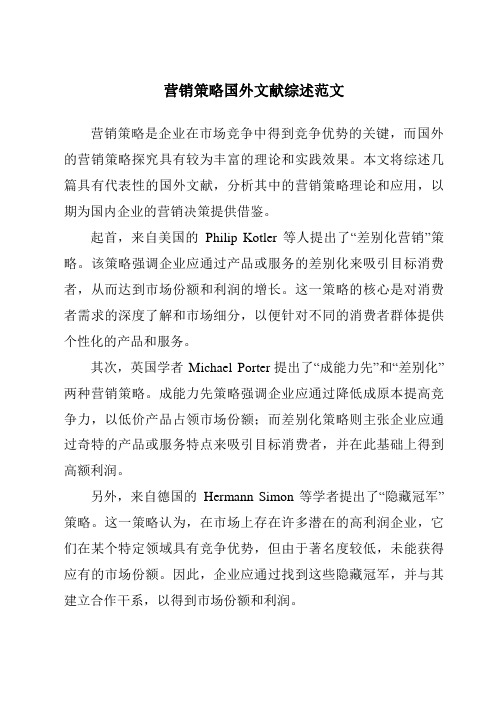
营销策略国外文献综述范文营销策略是企业在市场竞争中得到竞争优势的关键,而国外的营销策略探究具有较为丰富的理论和实践效果。
本文将综述几篇具有代表性的国外文献,分析其中的营销策略理论和应用,以期为国内企业的营销决策提供借鉴。
起首,来自美国的Philip Kotler等人提出了“差别化营销”策略。
该策略强调企业应通过产品或服务的差别化来吸引目标消费者,从而达到市场份额和利润的增长。
这一策略的核心是对消费者需求的深度了解和市场细分,以便针对不同的消费者群体提供个性化的产品和服务。
其次,英国学者Michael Porter提出了“成能力先”和“差别化”两种营销策略。
成能力先策略强调企业应通过降低成原本提高竞争力,以低价产品占领市场份额;而差别化策略则主张企业应通过奇特的产品或服务特点来吸引目标消费者,并在此基础上得到高额利润。
另外,来自德国的Hermann Simon等学者提出了“隐藏冠军”策略。
这一策略认为,在市场上存在许多潜在的高利润企业,它们在某个特定领域具有竞争优势,但由于著名度较低,未能获得应有的市场份额。
因此,企业应通过找到这些隐藏冠军,并与其建立合作干系,以得到市场份额和利润。
此外,来自日本的竹下登等学者提出了“服务营销”策略。
这一策略认为,企业应将服务作为核心竞争力,通过提供优质的售前、售中和售后服务,满足消费者的需求,提高客户满足度和忠诚度。
综上所述,国外的营销策略探究涵盖了差别化营销、成能力先、隐藏冠军和服务营销等多个方面。
这些策略在理论上提供了丰富的思路和方法,同时也在实践中取得了一定的成功。
国内企业在制定营销策略时,可以借鉴这些理论和实践效果,结合本土市场状况,提高市场竞争力和盈利能力。
营销策略英文参考文献
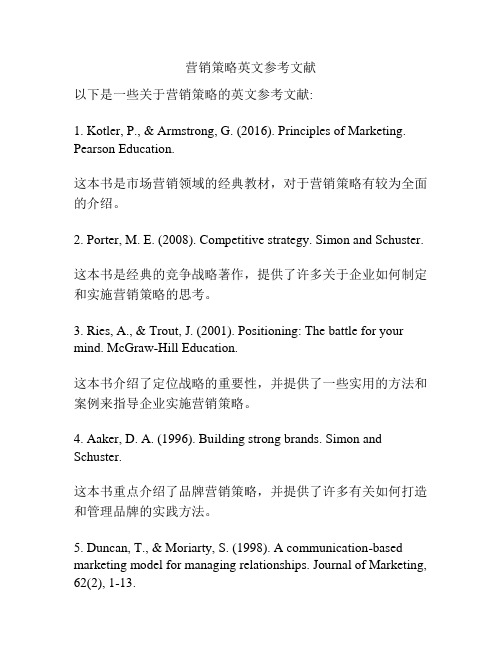
营销策略英文参考文献以下是一些关于营销策略的英文参考文献:1. Kotler, P., & Armstrong, G. (2016). Principles of Marketing. Pearson Education.这本书是市场营销领域的经典教材,对于营销策略有较为全面的介绍。
2. Porter, M. E. (2008). Competitive strategy. Simon and Schuster.这本书是经典的竞争战略著作,提供了许多关于企业如何制定和实施营销策略的思考。
3. Ries, A., & Trout, J. (2001). Positioning: The battle for your mind. McGraw-Hill Education.这本书介绍了定位战略的重要性,并提供了一些实用的方法和案例来指导企业实施营销策略。
4. Aaker, D. A. (1996). Building strong brands. Simon and Schuster.这本书重点介绍了品牌营销策略,并提供了许多有关如何打造和管理品牌的实践方法。
5. Duncan, T., & Moriarty, S. (1998). A communication-based marketing model for managing relationships. Journal of Marketing, 62(2), 1-13.这篇文章提出了一种基于沟通的营销模型,强调了营销策略在建立和管理关系方面的重要性。
这些参考文献涵盖了营销策略的不同方面,从市场定位到品牌建设,以及关系营销等。
阅读这些文献可以帮助你深入了解营销策略的理论和实践。
市场营销 外文翻译 外文文献 英文文献 差异化营销策略
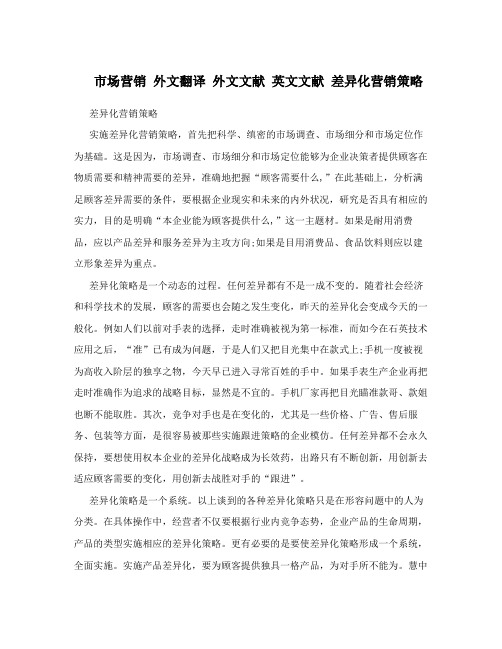
市场营销外文翻译外文文献英文文献差异化营销策略差异化营销策略实施差异化营销策略,首先把科学、缜密的市场调查、市场细分和市场定位作为基础。
这是因为,市场调查、市场细分和市场定位能够为企业决策者提供顾客在物质需要和精神需要的差异,准确地把握“顾客需要什么,”在此基础上,分析满足顾客差异需要的条件,要根据企业现实和未来的内外状况,研究是否具有相应的实力,目的是明确“本企业能为顾客提供什么,”这一主题材。
如果是耐用消费品,应以产品差异和服务差异为主攻方向;如果是目用消费品、食品饮料则应以建立形象差异为重点。
差异化策略是一个动态的过程。
任何差异都有不是一成不变的。
随着社会经济和科学技术的发展,顾客的需要也会随之发生变化,昨天的差异化会变成今天的一般化。
例如人们以前对手表的选择,走时准确被视为第一标准,而如今在石英技术应用之后,“准”已有成为问题,于是人们又把目光集中在款式上;手机一度被视为高收入阶层的独享之物,今天早已进入寻常百姓的手中。
如果手表生产企业再把走时准确作为追求的战略目标,显然是不宜的。
手机厂家再把目光瞄准款哥、款姐也断不能取胜。
其次,竞争对手也是在变化的,尤其是一些价格、广告、售后服务、包装等方面,是很容易被那些实施跟进策略的企业模仿。
任何差异都不会永久保持,要想使用权本企业的差异化战略成为长效药,出路只有不断创新,用创新去适应顾客需要的变化,用创新去战胜对手的“跟进”。
差异化策略是一个系统。
以上谈到的各种差异化策略只是在形容问题中的人为分类。
在具体操作中,经营者不仅要根据行业内竞争态势,企业产品的生命周期,产品的类型实施相应的差异化策略。
更有必要的是要使差异化策略形成一个系统,全面实施。
实施产品差异化,要为顾客提供独具一格产品,为对手所不能为。
慧中而秀外,还应该从包装到产品的宣传都显示出明显的差异,在顾客中建立难以忘怀的形象。
如果是耐用消费品,提供周到的服务,让顾客处处感到方便、安全,更是不可或缺的。
差异化营销策略研究外文文献翻译2017

差异化营销策略研究外文文献翻译2017The purpose of this research is to XXX.2.Literature ReviewBrand XXX and distinctive identity for a brand in the mindsof consumers。
This can be achieved through us means。
such as product design。
advertising。
pricing。
XXX brand from competitors。
companies XXX increase their market share.XXX can influence brand n。
including the product category。
the target audience。
and the competitive landscape。
For example。
in a crowded market with many similar products。
XXX。
by focusing on unique product features or targeting a specific niche audience。
companies can still differentiate their brand and stand out from competitors.3.MethodologyXXX brand n and its XXX。
this research XXX us industries。
as well as through a review of XXX studies.4.FindingsXXX。
XXX brand from competitors can create a strong brand identity and XXX。
Differentiation Marketing Strategy差异化营销策略(英文版)
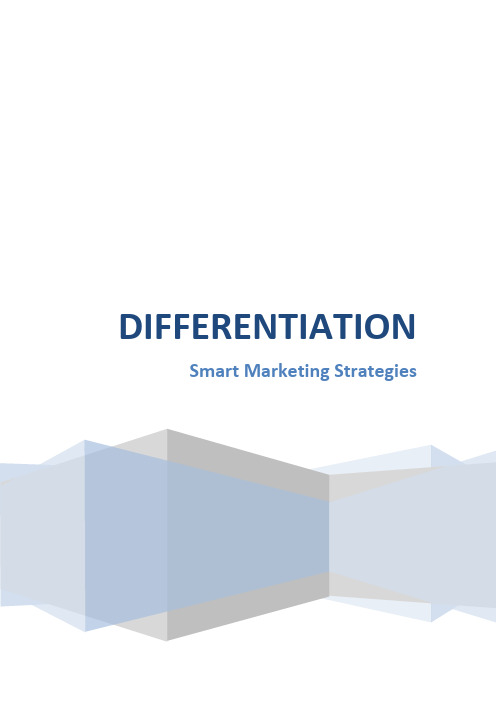
DIFFERENTIATION Smart Marketing StrategiesDIFFERENTIATIONSMART MARKETING STRATEGIESBy Terri ZwierzynskiAre you ever frustrated or hesitant when you talk to prospective customers because you can't readily explain why they should come to you rather than go to your competitors? Sure, you might have your 30-second elevator speech, but then they ask you that dreaded question, so what makes you different? Then, all those self-doubts creep in, and you just aren't sure what to say. Differentiation can boost confidence--yours in yourself and that prospective customer's confidence in you!Dif-fer-en-ti-ate v. tr. To perceive or show the difference in or between; discriminate.In business terms, to differentiate means to create a benefit that customers perceive as being of greater value to them than what they can get elsewhere. It's not enough for you to be different--a potential customer has to take note of the difference and must feel that the difference somehow fits their need better. (Other words that mean virtually the same thing: Competitive Advantage; Unique Selling Proposition; or Value Proposition.) As you are building your business, you can use differentiation to attract more customers. Once you have momentum, differentiation allows you to charge a higher price because you are delivering more value to your customers. Make a point to evaluate and adjust your differentiation methods at least annually.The various methods of differentiating your businesses fall into four general categories:∙Price Differentiation∙Focus Differentiation∙Product/Service Differentiation∙Customer Service DifferentiationPrice DifferentiationDifferentiating on price is probably the most common and easily understood method. HOWEVER, caution is in order. On the one hand, potential customers might expect a lower price from you than from your larger competition because they perceive you as having less overhead, etc. On the other hand, cheaper prices can evoke perceptions of lower quality, a less-stable business, etc. And if you compete on price against competitors with deeper pockets, you can price yourself right into bankruptcy. Be creative with this differentiator by competing on something other than straight price. For example, you might offer: ∙More value - offer more products or services for the same price.∙Freebies - accessories, companion products, free upgrades, and coupons for future purchases.∙Free shipping, etc. - convenience sells, especially when it is free!∙Discounts - includes offering regular sales, coupons, etc. (see cautions above)Focus DifferentiationThis is the most important method of differentiation, and in many ways, the easiest. Why? Because you simply can't be everything to everybody, so you must pick a specific way to focus your business. Once you have done that, you have an automatic advantage over larger companies because you can become more of an expert in that one field --and you can build close relationships with key customers that will be hard to duplicate. For example, you might differentiate yourself through:∙Location - take advantage your closeness to prospective customers.∙Customer specialization - be very specific about what characteristics your customers will have for example, racing bicycle enthusiasts or companies with a spiritualconscience.∙Customer relationships - know customers really well, form partnerships with them, and get them to speak for you!∙Affinity relationships - associate your product/service with a well-known person or organization.∙One-stop shopping - offer everything your target market needs, in your area of expertise.∙Wide selection (within your niche) although this one may seem to be the opposite of focus - the key is to be very specific in one dimension and very broad in another.Product/Service Offering DifferentiationHow much you are able to differentiate your product or service offering will vary based on what type of business you are in. For instance, if you are in a highly regulated business, your options may be limited. Explore a totally new market or type of product or service, however, and the possibilities abound. The key to successful differentiation in this category, again, is to know your customers, really, really well. Talk to them often, and you will know what they need most and be able to offer it, long before your competitors know what is happening. For example, your product or service could stand out in one of these ways:∙Quality - create a product or service that is exceptional in one or more ways.Examples: Lasts longer --Better --Easier to use --Safer∙New/First - be the first one to offer something in your location/field.∙Features/Options - offer lots of choices, unusual combinations, or solve a problem for a customer in a way no one else does.∙Customization - you may be able to more easily handle special orders than big, mass-market competitors.Customer Service DifferentiationHave you noticed how customer service seems to be out of vogue these days? This situation makes excellent customer service a great opportunity for differentiation and another natural advantage for entrepreneurs that already know what s important to their customers. Build your reputation on making customers feel really good about doing business with you. Works great with referral marketing, too. Examples:∙Deliver Fast - next day, or one-hour--make it faster than customers think possible.∙Unique channel - offer a service over the phone or Internet instead of in person or in their office rather than yours.∙Service-delight customers! - it may seem expensive to offer exceptional service--but it pays off in word-of-mouth advertising.∙Before/during/after-sales support - provide technical or other support to customers using your product. You might use joint ventures to provide that support--butcustomers will perceive it as being from you!∙Guarantee/warranty - offer 100% money-back, or free replacement parts.∙YOU - offer yourself, your unique blend of talents and skills, to attract customers.Make sure they get access to you, too!Keys to Successful Differentiation:∙Know your customers, really, really well.∙Pick a blend of differentiation methods that, in the eyes of your customers, truly sets you apart.∙Talk about your differentiation in terms of customer benefits.∙Tell everyone about what differentiates you--often.∙Keep your differentiation fresh by listening for changing customer needs.。
关于营销策略的外文文献
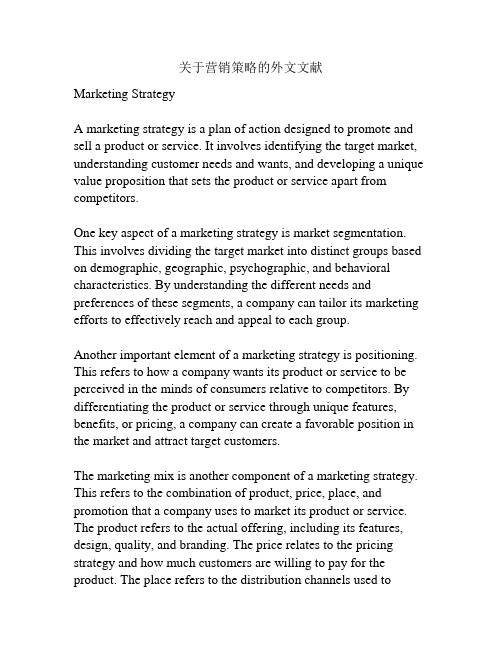
关于营销策略的外文文献Marketing StrategyA marketing strategy is a plan of action designed to promote and sell a product or service. It involves identifying the target market, understanding customer needs and wants, and developing a unique value proposition that sets the product or service apart from competitors.One key aspect of a marketing strategy is market segmentation. This involves dividing the target market into distinct groups based on demographic, geographic, psychographic, and behavioral characteristics. By understanding the different needs and preferences of these segments, a company can tailor its marketing efforts to effectively reach and appeal to each group.Another important element of a marketing strategy is positioning. This refers to how a company wants its product or service to be perceived in the minds of consumers relative to competitors. By differentiating the product or service through unique features, benefits, or pricing, a company can create a favorable position in the market and attract target customers.The marketing mix is another component of a marketing strategy. This refers to the combination of product, price, place, and promotion that a company uses to market its product or service. The product refers to the actual offering, including its features, design, quality, and branding. The price relates to the pricing strategy and how much customers are willing to pay for the product. The place refers to the distribution channels used todeliver the product to customers, while promotion encompasses the various marketing communications tools used to create awareness and generate sales.A successful marketing strategy also involves setting clear objectives and metrics to measure the effectiveness of marketing efforts. This may include goals such as increasing market share, expanding into new markets, or improving customer satisfaction. By regularly evaluating and adjusting the marketing strategy based on these metrics, a company can ensure that its marketing efforts are aligned with its overall business objectives.In today's digital age, technology plays a crucial role in shaping marketing strategies. Companies can leverage social media, search engine optimization, and data analytics to better understand customer behavior and preferences. Additionally, personalized marketing strategies can be developed based on the data collected from customer interactions, allowing companies to deliver targeted messages and offers to individual customers.In conclusion, a marketing strategy is a comprehensive plan that encompasses market segmentation, positioning, the marketing mix, and the measurement of outcomes. By carefully crafting and executing a marketing strategy, companies can effectively reach and engage their target market, differentiate themselves from competitors, and ultimately achieve their business objectives.。
差异化营销 differentiated marketing

差异化营销differentiated marketing什么是差异化营销所谓差异化营销(differentiated marketing)差异性市场战略(differentiated marketing tactics)差异性市场策略,又叫差异性市场营销,是指面对已经细分的市场,企业选择两个或者两个以上的子市场作为市场目标,分别对每个子市场提供针对性的产品和服务以及相应的销售措施。
企业根据子市场的特点,分别制定产品策略、价格策略、渠道策略以及促销策略并予以实施。
差异化营销的核心思想差异化营销,核心思想是“细分市场,针对目标消费群进行定位,导入品牌,树立形象”。
是在市场细分的基础上,针对目标市场的个性化需求,通过品牌定位与传播,赋予品牌独特的价值,树立鲜明的形象,建立品牌的差异化和个性化核心竞争优势。
差异花营销的关键是积极寻找市场空白点,选择目标市场,挖掘消费者尚未满足的个性化需求,开发产品的新功能,赋予品牌新的价值。
差异化营销的依据,是市场消费需求的多样化特性。
不同的消费者具有不同的爱好、不同的个性、不同的价值取向、不同是收入水平和不同的消费理念,等,从而决定了他们对产品品牌有不同的需求侧重,这就是为什么需要进行差异化营销的原因。
差异化营销不是某个营销层面、某种营销手段的创新,而是产品、概念、价值、形象、推广手段、促销方法等多方位、系统性的营销创新,并在创新的基础上实现品牌在细分市场上的目标聚焦,取得战略性的领先优势。
差异化营销的形式企业可以选择几个利益最大的子市场做为目标市场,如果有足够的能力满足更多的子市场则可以选择更多的子市场;如果各子市场对企业都很有吸引力,并且企业也有能力为各子市场提供不同的产品和服务,企业可以把子市场作为目标市场。
在世界著名的跨国公司中,宝洁公司是实行差异化营销的典型,它的洗衣粉就有11个品牌,中国妇孺皆知的有强力去污的“碧浪”,价格教较高;去污亦强但价格适中的“汰渍”;突出物廉价美的“熊猫”。
- 1、下载文档前请自行甄别文档内容的完整性,平台不提供额外的编辑、内容补充、找答案等附加服务。
- 2、"仅部分预览"的文档,不可在线预览部分如存在完整性等问题,可反馈申请退款(可完整预览的文档不适用该条件!)。
- 3、如文档侵犯您的权益,请联系客服反馈,我们会尽快为您处理(人工客服工作时间:9:00-18:30)。
外文翻译差异化营销策略原文来源:.[U.S.] • Philip Kotler was, Mei Qinghao translation. Marketing Management [M]. Century Publishing Group, Shanghai People's Publishing House, 2003 p256—p259更多原创经管论文及英文文献与翻译请访问:http://经管论文.com/ ,并提供定制服务译文正文:实施差异化营销策略,首先把科学、缜密的市场调查、市场细分和市场定位作为基础。
这是因为,市场调查、市场细分和市场定位能够为企业决策者提供顾客在物质需要和精神需要的差异,准确地把握“顾客需要什么?”在此基础上,分析满足顾客差异需要的条件,要根据企业现实和未来的内外状况,研究是否具有相应的实力,目的是明确“本企业能为顾客提供什么?”这一主题材。
如果是耐用消费品,应以产品差异和服务差异为主攻方向;如果是目用消费品、食品饮料则应以建立形象差异为重点。
差异化策略是一个动态的过程。
任何差异都有不是一成不变的。
随着社会经济和科学技术的发展,顾客的需要也会随之发生变化,昨天的差异化会变成今天的一般化。
例如人们以前对手表的选择,走时准确被视为第一标准,而如今在石英技术应用之后,“准”已有成为问题,于是人们又把目光集中在款式上;手机一度被视为高收入阶层的独享之物,今天早已进入寻常百姓的手中。
如果手表生产企业再把走时准确作为追求的战略目标,显然是不宜的。
手机厂家再把目光瞄准款哥、款姐也断不能取胜。
其次,竞争对手也是在变化的,尤其是一些价格、广告、售后服务、包装等方面,是很容易被那些实施跟进策略的企业模仿。
任何差异都不会永久保持,要想使用权本企业的差异化战略成为长效药,出路只有不断创新,用创新去适应顾客需要的变化,用创新去战胜对手的“跟进”。
差异化策略是一个系统。
以上谈到的各种差异化策略只是在形容问题中的人为分类。
在具体操作中,经营者不仅要根据行业内竞争态势,企业产品的生命周期,产品的类型实施相应的差异化策略。
更有必要的是要使差异化策略形成一个系统,全面实施。
实施产品差异化,要为顾客提供独具一格产品,为对手所不能为。
慧中而秀外,还应该从包装到产品的宣传都显示出明显的差异,在顾客中建立难以忘怀的形象。
如果是耐用消费品,提供周到的服务,让顾客处处感到方便、安全,更是不可或缺的。
值得指出的是,任何一种差异化策略的实施都要会出一定的代价,如增加售后服务项目就要加大销售成本,加大宣传力度就要支出一大笔广告费用,但只要顺利达到预想的差异化效果,或者能为企业带来长远的利益,这种选择就是值得的进入二十一世纪,带给我们的是信息时代到注意力时代的转变,有了更多更广更纷繁复杂的信息,信息以爆炸方式激增,而人们有限的注意力,怎样才能吸引人们的注意力保证企业的竞争优势呢?激烈的市场竞争使得企业为了出售其产品,不惜在营销手段和方式上不断出新、出奇,花样百变,夺人耳目。
但是,过犹不及也适用于营销,营销手段用的过度也会产生副作用。
各种战术轮番轰炸,让人在初感新奇之后,就会产生疲劳与厌恶感。
如何合理的运用营销策略在注意力经济的环境下显得尤为重要。
怎样才能在吸引消费者的眼球,引起注意力的同时又不让人感觉到乏味无聊,甚至是反感,因此我们要合理的运用营销手段。
1 基于注意力经济下的营销策略状况分析1.1 注意力经济的提出“注意力经济”这一观点最早见于美国加州大学学者Richard wbam在1994年发表一篇题为《注意力的经济学》(The Economics of Attention)的文章。
最早正式提出“注意力经济”这一概念的是美国的迈克尔•戈德海伯(Michael H.Goldhaber)1997年在美国发表了一篇题为《注意力购买者》的文章。
他在这篇文章中指出,目前有关信息经济的提法是不妥当的,因为按照经济学的理论,其研究的主要课题应该是如何利用稀缺资源。
对于信息社会中的稀缺资源,他认为,当今社会是一个信息极大丰富甚至泛滥的社会,而互联网的出现,加快了这一进程,信息非但不是稀缺资源,相反是过剩的。
而相对于过剩的信息,只有一种资源是稀缺的,那就是人们的注意力。
“随着互联网的发展,有价值的不再是信息,而是你的注意力。
”这是诺贝尔经济奖获得者赫伯特•西蒙说过的。
的确在这个信息爆炸的时代,如何使自己的信息有效的传达给目标群体就是注意力经济所要研究的问题,同时又要做到适时的切合消费者的心智模式,找到情感上的共鸣。
1.2 营销手段在注意力经济下的例证分析1.2.1 2008年奥运的超级营销2008年的夏天,让亿万人铭记,我们国家成功举办了第29夏季奥运会,全世界的目光都集中在了中国北京。
在这里是各国体育健儿友谊竞争的舞台,也是我们国家展示国家实力的舞台,更是各个商机蕴含的源泉。
不难发现很多企业都用这个舞台实现了企业飞腾。
可口可乐、联想、GE、韩国三星电子等都成为了北京奥运会的全球合作伙伴,这些品牌遍及了全球范围,让各个品牌利用奥运会宣传自己的同时,也让北京奥运会走进了全世界千家万户,让更多的人关注了解北京奥运。
不能成为全球的合作伙伴,阿迪达斯、中国石化、海尔、中国网通、搜狐、中国银行等品牌择其次成为了合作伙伴、独家供应商、赞助商,也借奥运这股风,将品牌影响力带到了各个角落。
1.2.2 过度营销“送礼就送脑白金”这句话,大家依然熟悉,我们不可忽视它当时带来的轰动效应,大家送礼都送脑白金。
铺天盖地的广告,脑白金带了了保养品的销售高潮。
脑白金也成功的将消费者的眼球吸引住,成功的达到了注意力经济的目标点。
然而,时隔不久,观众对“脑白金”的“今年过节不收礼,收礼只收脑白金”和“黄金搭档”的“送老师、送亲友、送领导”广告很反感,这就是过度营销带来的后果,太多的广告,太多的观念灌输,缺乏新的吸引点导致了陈旧带来的不良影响,给企业的形象带来弊端。
2 营销手段的合理运用2.1 建立有竞争力的企业品牌一个企业保持竞争优势首先在于创立起企业的文化,品牌价值,当企业的文化,品牌价值较高的时候,企业的品牌已是吸引顾客的注意力的有效手段,不再需要过多的广告来进行轰炸式宣传。
像我们熟悉的宜家就带展示了经济、环保、方便的家居用品,直接吸引了广大消费之的注意力;在运动品牌里,我们大家会很自然的想到耐克、阿迪达斯这样的国际品牌,因为它们的品牌文化向我们提供了运动的美与健康,吸引着我们的注意力。
可见,要在注意力经济下得到消费者的青睐,要长期的保持这样的竞争力,首先就要有强势的企业品牌,文化底蕴。
2.2 差异化的营销当产品的同质性越来越强的时候,企业要引起大家的注意力,必然就要体现自己的不同。
差异化意味着与众不同、独树一帜、独一无二。
差异化策略凸现了产品的优势,差异化才能引起大众的关注,才能掠夺大众的注意力。
差异化有多种实现方法,不管是产品包装、功能、价格、广告甚至精神文化理念等,我们都有可能找到差异化的突破点。
比如我们所熟悉的饮料“王老吉”,既是在功能上的创新,也是品牌个性上的创新,一般饮料的功能是解渴,王老吉在其中加入“预防上火”的功能,除了解渴,还能防止上火。
王老吉作为第一个预防上火的饮料推向市场,打破了长期以来人们对饮料的观念,新功能的增加,受到了大部分人的认同和喜爱。
在注意力经济时代,企业需要想方设法吸引消费者的眼球,在成功吸引眼球的同时不能引起大众的反感,企业就要合理的运用营销手段,恰如其分运用好各种营销的战略战术,才能使企业获得企业竞争优势。
同时社会是不断发展的,市场环境也不断变化,消费者、竞争对手也都在不断地变化调整着,自己的差异化竞争优势也可能明天就被人模仿,那么企业自身一地要不断的变化,求实创新,保持差异化。
原文正文:Implementation of differentiated marketing strategy, first of all the scientific, careful market research, market segmentation and market positioning as a basis. This is because market research, market segmentation and market positioning can provide customers with enterprise decision-makers in material differences between the needs and spiritual needs, and accurately grasp the "customer needs what?" On this basis, analysis to meet customer needs Tiaojian difference , according to the present and future business conditions inside and outside, whether the corresponding strength of purpose is clear, "the company can provide customers with what?" the subject material. If consumer durables, and services should be based on product differentiation between the main direction; If it is present with the consumer goods, food and beverage to create the image difference should be the focus.Differentiation strategy is a dynamic process. Any differences are not static. With the socio-economic and scientific and technological development, the needs of customers can be changed, the difference yesterday, of today will become generalized. For example, people watch previous choices, and take the accuracy Pi Shiwei first standards, now in quartz Jishu applications once and "associate" has become a question, so people focus more on style, on again; phone once regarded as high Shouru exclusive class of objects, and today well into the hands of ordinary people. If the watch manufacturer as the pursuit of accurate time and then the strategic objectives, is clearly inappropriate. Sights on mobile phone manufacturers shall then brother, sister models also can never win. Second, competition is also changing, especially some of the price, advertising, service, packaging and so it is very easy to follow up the implementation of strategies that companies imitate. Any differences will not be permanently maintained, in order to use the power of the company's differentiation strategy as long-acting drugs, the solution is only continuous innovation to meet customer needs with innovative changes, using innovation to beat the "follow-up."Differentiation strategy is a system. The differences in the above mentioned strategy was describing the problem of human classification. In actual operation, the operator not only according to industry competition, and enterprise product life cycle, the implementation of the appropriate type of product differentiation strategy. More necessary to make the differentiation strategy is a systematic and comprehensive implementation. Implementation of product differentiation, to provide customers with a unique style products, rivals can not. Hui in the show, it also should promote the product from the packaging to show significant differences are in the customer create an unforgettable image. If consumer durables, to provide good service for customers everywhere are convenient, safe, it is indispensable. It is worth noting that any differences in the implementation strategy must be a certain price, such as increasing the service project would increase the cost of sales and step up publicity to pay for the cost of a large amount of advertising, but as long as progress was the desired effect of differentiation, or to bring long-term benefits for the enterprise, this option is worth it.Into the twenty-first century is the information age has brought us to the attention of the times change, broader and more complex with more information, the information explosion means to surge, and people with limited attention, how can we attract people attention to ensure the competitive advantage? Intense competition in the market allows companies to sell their products at the way in marketing and constantly new, surprising and amazing tricks, won for them. But too far also applies to marketing, marketing will also have side-effects of excessive use. Bombarded with a variety of tactics, people feel strange at first before we can produce a sense of fatigue and disgust.The reasonable use of marketing strategies in the attention economy of the environment is very important. How to attract the attention of consumers, causing people to feel that attention without boring, even offensive, so we have to a reasonable use of marketing.1 Based on marketing strategy in Attention Economy AnalysisThe proposed 1.1 Attention Economy"Attention Economy" This view was first seen in the University of California scholar Richard A. Lawbam published in 1994 entitled "attention economics" (The Economics of Attention) article.The first official presentation of the "attention economy" concept is the United States, Michael • Gedehaibo (Michael H. Goldhaber) 1997 in the United States published a paper entitled "Attention buyers," the article. In this article he pointed out, the current information economy was not appropriate, because according to economic theory, the main topics of their research should be how to use scarce resources. For scarce resources in the information society, he believes that today's society is a great wealth of information and even run rampant, and the Internet, to speed up this process, information not only not the scarce resource, the opposite is the surplus. The relative excess of information, only one resource is scarce, it is the people's attention."With the development of the Internet is not valuable information, but your attention."This is the Nobel Prize-winning economist Herber t • Simon said. Indeed, in this era of information explosion, how to effectively communicate their message to the target group is the attention economy to study the issue, at the same time to achieve timely mental models to meet consumers find the emotional resonance.1.2 marketing in the example of Attention Economy1.2.1 The 2008 Olympic super-marketingThe summer of 2008, hundreds of millions of people in mind, our country successfully hosted the 29th Summer Olympic Games, the world's eyes are on China's Beijing. Here is the friendship between athletes competing national stage, but also show our country's national power stage, it is the source of all business opportunities contain. Is not difficult to find a lot of companies are using this stage to achieve the business soar.Coca-Cola, Lenovo, GE, Samsung and so become a global partner of the Beijing Olympic Games, these brands across the global scope, use the Olympics to promote their various brands, but also for the Beijing Olympics into thousands of households around the world, so that more people are concerned about the Beijing Olympics. Can not become a global partner, adidas, Sinopec, Haier, China Netcom, Sohu, followed by the Bank of China and other brands to become the partner selection, exclusive suppliers, sponsors, and the Olympic Games that shares the wind, the brand brought to all corners of the force.1.2.2 Over Marketing"Gifts would send melatonin", that is, we still know, we can not ignore it caused a great sensation, then we have to send a gift melatonin. Omnipresent advertising, melatonin brought an upsurge in sales of skin care products. Melatonin has also successfully attracted the attention of consumers, the success of reaching the goal point attention economy. However, long after that, the audience, "melatonin" and "does not receive this year's festive, gifts received only melatonin" and the "golden couple" of "sending teachers to send friends and relatives, sent to lead" ads are offensive, and this is over the consequences of marketing, too many ads, too many ideas indoctrination, lack of new attractions has led to the adverse effects of old, to bring the image of corporate malpractice.2, proper use of marketing tools2.1 The establishment of a competitive brandFirst of all, a company maintain a competitive edge is created from the corporate culture, brand value, when the corporate culture, when a high brand value, corporate branding is to attract the attention of customers an effective means of advertising is no longer required too much bombing-style propaganda. IKEA as we are familiar with shows on the economic, environmental, and convenient household items, large consumption of directly attracting attention; in the sports brand, we thought we would be very natural for Nike, Adidas such international brand, because their brand culture provides us with the beauty and health campaign to attract our attention. Can be seen in the attention economy to get consumers to maintain such long-term competitiveness, we must first have a strong corporate brand and culture.Differentiated marketing 2.2When the growing homogeneity of the product when the market will have everyone's attention, certainly must reflect their different. Differentiation means that different, unique, unique. Product differentiation strategy highlights the advantages of differentiation can lead to public concern, to plunder the public's attention. Differentiation has a variety of ways, whether it is product packaging, features, price, advertising and even spiritual and cultural ideas, and we are likely to find differences in the breakthrough point.For example we are familiar with drink, "Wong Lo Kat", both in functional innovation, innovation is the brand personality, the general function is to drink thirst, which joined the Wong Lo Kat "prevention lit" function, in addition to thirst, but also to prevent the fire. Wong Lo Kat lit prevention as the first beverage market, breaking the long-standing notion people drink, the increase of new features, by most people's recognition and love.In the attention economy of the times, companies need to strive to attract the attention of consumers, while at attracting eyeballs can not arouse public resentment, enterprises must use reasonable marketing tool, appropriately good use of various marketing strategies and tactics to enable enterprises to competitive advantage. At the same time continuous development of society, and the changing market environment, consumers, competitors are also constantly changing to adjust with, their differentiation competitive advantage may be one tomorrow, imitation, then the business itself to be a constant change , realistic and innovative, to maintain differentiation.。
